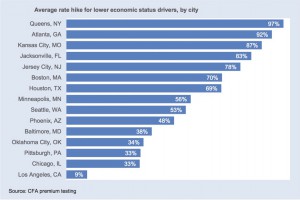
The difference among the top five auto insurers in 15 cities based on what a driver makes can be substantial.
Auto insurers use a variety of factors to determine what they should charge consumers, and not all are fair; however, one seems to punish those who can – so it seems – least afford it: lower wage earners.
A new study by the Consumer Federation of America shows that drivers with a lower socio-economic status were charged an average of 59% more, equating to $681, annually than drivers with identical driving histories, but with better salaries.
“Insurance companies should judge you on how you drive, not who you are,” said J. Robert Hunter, CFA’s Director of Insurance and former Texas Insurance Commissioner.
“Insurance companies are penalizing good drivers by hundreds and sometimes thousands of dollars each year based on economic and social status, and the end result is that the poor pay more, much more.”
Why is it important? Because regardless of how much money one makes, everyone is required by law to buy auto insurance, except in New Hampshire. The CFA is proposing that a driver’s record should be the only factor in determining premium costs.
(New car sales expected to flatten in June. For more, Click Here.)
The CFA study analyzed premiums charged by the nation’s five largest insurers in 15 cities across the country to determine the results. In its study, CFA tested the impact of the following five factors commonly used by insurers to price auto insurance:
- Level of Education
- Occupation
- Homeownership status
- Ownership of a car during prior six months
- Marital status
Despite having the exact same driving record and living at the same address, drivers pay higher premiums 92% of the time if they have a high school degree and a blue collar or hourly job, rent their home, have not owned a car (and had no auto insurance) for the past six months, and are unmarried. Each of these is associated with lower economic status, according to the CFA.
(Click Here for details about Jeep adding EVs and PHEVs.)
GEICO and Progressive topped the companies with the biggest increases at 92% and 80% respectively while Allstate and Farmers hit drivers with the highest average annual dollar increases: $915 and $900. Conversely, State Farm charged a 13%, or $217, annual increase.
(Is Progressive car insurance worth it?)
Only about 10% of Americans believes the use of economic factors or credit score to determine annual insurance premiums is “very fair.”
“The American people don’t like the idea of insurance companies using personal and economic factors to set premiums, even though most people don’t realize how much of an impact these non-driving characteristics have on the price they pay for coverage,” said the study’s co-author Doug Heller.
The impact of each economic factor varied by company and from city to city, but drivers in almost every city in the study saw rates rise by at least 33% on average after accounting for the cumulative impact of the five factors. No where did the rate go down after the factors were applied.
(To see more about why the Brexit vote has the world’s automakers worried, Click Here.)
Los Angeles was the only city tested in which there was consistently little difference between the lower economic status driver and the upper economic status driver. This is because, under California’s consumer protection laws, all of the non-driving factors tested in this report are prohibited from use in auto insurance pricing in California with the exception of marital status, which accounts for the 9$, or $80 per year, average premium difference seen in Los Angeles, according to the CFA.

The rank correlates to cities / areas where there are more likely more economically poor people than “rich” people